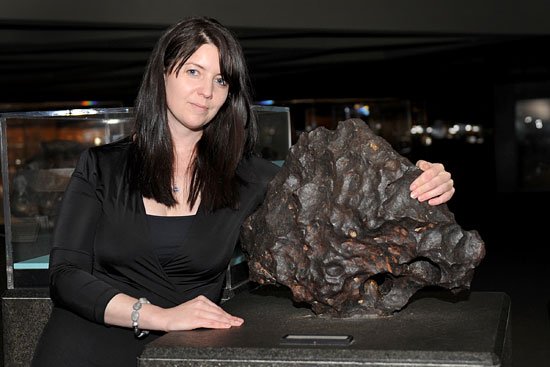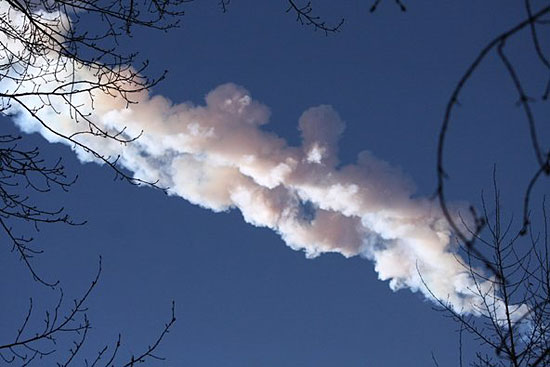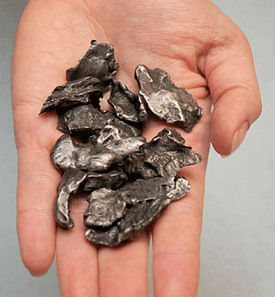Meet L.A.’s oldest meteoric stars
February 22, 2013
Last week’s Russian meteor strike may have been astonishing (not to mention hazardous to thousands of Siberians), but great balls of fire can land anywhere—even in greater Los Angeles.
Take the 30-pound Neenach meteorite—4.5 billion years old, give or take a few hundred million—that was turned up by a plow in 1948 by an Antelope Valley rancher. Or the 42-pound Littlerock meteorite, found on a farm in 1979 near Palmdale.
There are even a pair of rare Martian meteorites named for Los Angeles County, though technically the collector who discovered them said he can’t recall precisely where in the Mojave Desert he stumbled across them; the two lava chunks, weighing about a pound and a half-pound, respectively, languished for nearly two decades in a box of loose rocks at his home in Sunland, until he took them in 1999 to UCLA for testing.
Now, a thin slice of “Los Angeles 002,” as the smaller meteorite is now known, is behind glass at the Natural History Museum of Los Angeles County, along with the other aforementioned local examples of primordial stardust.
“Meteorites are hitting the Earth constantly,” notes Alyssa R. Morgan, collections manager in the gems and minerals department of the Natural History Museum.
“Most of them are as tiny as dust or sand grains, but they make the Earth bigger every day.”
Like geologists the world over, Morgan’s mind has been on last Friday’s extraterrestrial fly-by as the museum has braced for Los Angeles’ usual response to meteor-related publicity. The meteorite, which is estimated to have been 55 feet in diameter, rained black and brown fragments for miles across the snow as it streaked across the Ural Mountains, shattering windows and injuring some 1,200 people. Though the bulk of it has yet to be recovered, it is believed to be the largest such object to have hurtled to Earth in more than 100 years.
“Usually after a newsworthy event like the one in Russia, we get lots of calls from people saying, ‘You know, I found this funky rock a while ago and I’ve been meaning to have it tested’,” says Morgan, who has been fascinated by meteorites since her childhood in Seattle, and who studied moon rocks as a graduate student at Brown University. “Ninety-nine times out of 100, they’re not meteorites.
“We have had some real ones come in, though. Last year, a guy who buys storage lockers at auctions brought in a box of rocks so carefully wrapped that he figured the person he’d bought them from had to have been a collector. It turned out he was right, although we never did hear what he decided to do with them.”
Meteorites are meteors—typically asteroids or fragments of asteroids, moons or planets—that have made it through the Earth’s atmosphere and landed.
Some meteorites, Morgan says, are remnants of planets shattered long ago in collisions; others are chunks of existing planets and moons that were chipped at extreme velocity by other meteorites.
No meteorite is believed to have ever killed a human being, though they’ve reportedly landed several times on houses, workplaces and, in at least one verified instance, a doctor’s office in Virginia. In 1911, the famous Nakhla meteorite allegedly killed a dog in Egypt (though that’s been disputed.)
But all meteorites, she says, are time capsules.
“They’re primitive pieces of what everything in our solar system, including our sun, is made of,” says Morgan. “That’s part of why meteorites give us tremendous insight.”
The Natural History Museum’s meteorite collection is modest compared to those, say, at the Smithsonian Institution or the research collection at the Institute of Geophysics and Planetary Physics at UCLA.
Morgan says the NHM collection currently has about 50 specimens. One, a piece of the Argentine Campo del Cielo meteorite, was purchased especially for the new Dinosaur Hall to help illustrate the ongoing debate over whether climate change or a catastrophic meteor strike cleared the way for the age of mammals.
But the most notable other specimens are on display in the museum’s Gem and Mineral Hall. They range from a coin-sized sliver of a rare lunar meteorite found in Libya in the late 1990s to a good-sized hunk of the Canyon Diablo meteorite, which fell in Arizona some 50,000 years ago, creating a massive crater. The latter was instrumental in the determination—by Caltech geochemist Clair Patterson in the 1950s—that the Earth is about 4.55 billion years old.
“Before that work, people knew the Earth was old, but had no way to calculate its age,” says Morgan, running her hand along the big, dark meteorite’s dented surface. “Through this rock, we learned something we now take for granted—how old we are.”

Alyssa Morgan with a chunk of the Canyon Diablo meteorite, which helped scientists determine the Earth
Posted 2/22/13
















 405 bridge work causes a stink
405 bridge work causes a stink